How the production workshop moved to the free energy of the sun
Last year, I already wrote about solar power plants and this found an echo in the hearts of readers. This time I want to talk about a more powerful solar power plant that feeds the production hall. The power of solar panels alone is 27,000 watts!
Those who are too lazy to read, can watch the video, and those who like letters and pictures - under the cat
To begin with, the production is engaged in sawing and chromium laminating. Construction of hangars began in the open field and at first there was no power at all. Therefore, a 30 kW diesel generator was installed. They warmed themselves with a solid fuel stove, and the generator provided the power supply for the vehicles.
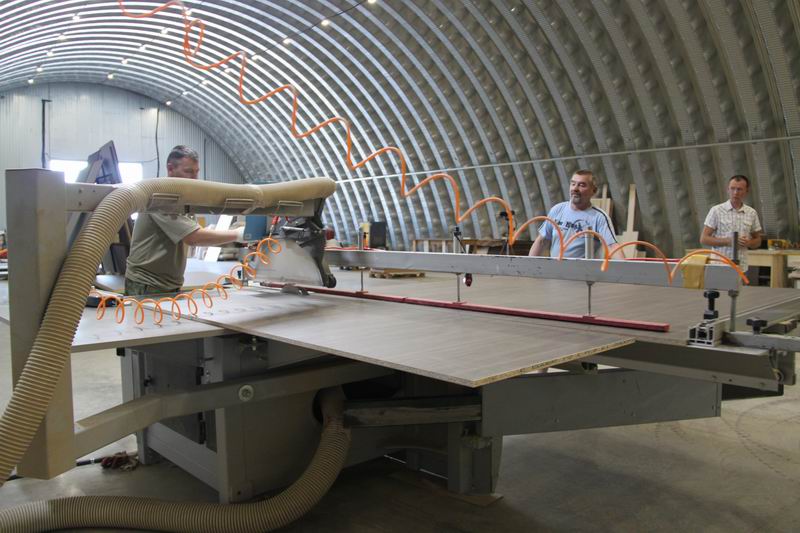
Pretty soon, the owner of the production thought about the cost of electricity received from the generator and came to the conclusion that it is foolish not to use the free energy of the sun, since all the production is in the Krasnodar region, where the sun is more than enough! Therefore, the task was to make the main source of energy a solar power station, and a backup diesel generator.
The first step was the miscalculation and presentation of several projects, of which one was chosen. After that, the equipment was mounted and running. Installation was carried out directly on the hangar itself. Since it is a semicircle, it turned out to be very easy to choose the optimal angle of the panels. Here and the sun is enough and the snow will not linger. In addition, the length of the hangar will increase the number of solar panels, if you need more energy.

Currently installed 100 panels with a capacity of 270 watts each. Polycrystalline panels were chosen, since they have a slightly lower cost, which made it possible to reduce the price of the system. Still, commercial exploitation implies a balance of price-quality. Since 27 kW is a serious power, especially since the panels produce direct current, the decision was made to use a mains inverter that supports the input voltage from the panels up to 1000 Volts. It turned out 4 blocks of solar batteries connected in series of 25 pieces. Operating voltage rose to 930 V.
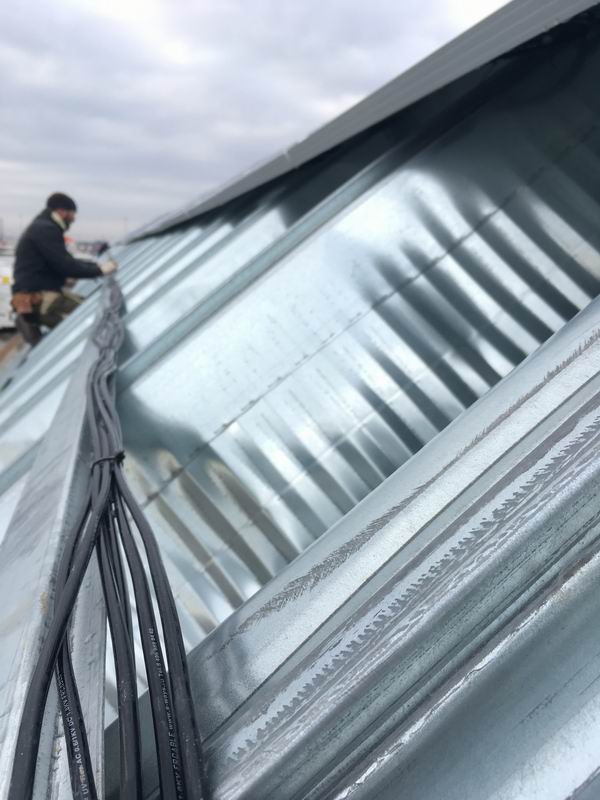
To transfer the voltage from the battery to the solar controller, a standard wire with a cross section of 6 sq. Mm was used, the coating of which is not afraid of ultraviolet radiation and various weather conditions. Despite the fact that each block of solar panels gives almost 7 kW, the current is 7-8 Amps, that is, for a given cross section, the current flow and losses are minimal.
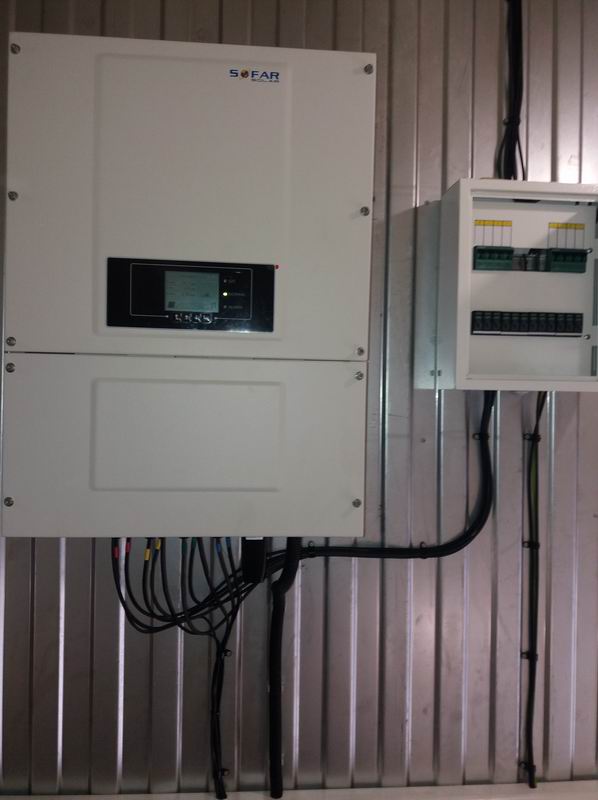
All energy from solar panels is collected by the Sofar 30000TL device. This is a three-phase mains inverter that is equipped with two MPPT controllers at once and can process up to 33 kW of solar energy. The advantage is that it works without batteries, and the minus results from the advantages - it can only work with a three-phase 380 V back-up network. That is, if the external network turns off, it will turn into a pumpkin and the solar panels will become a decoration.
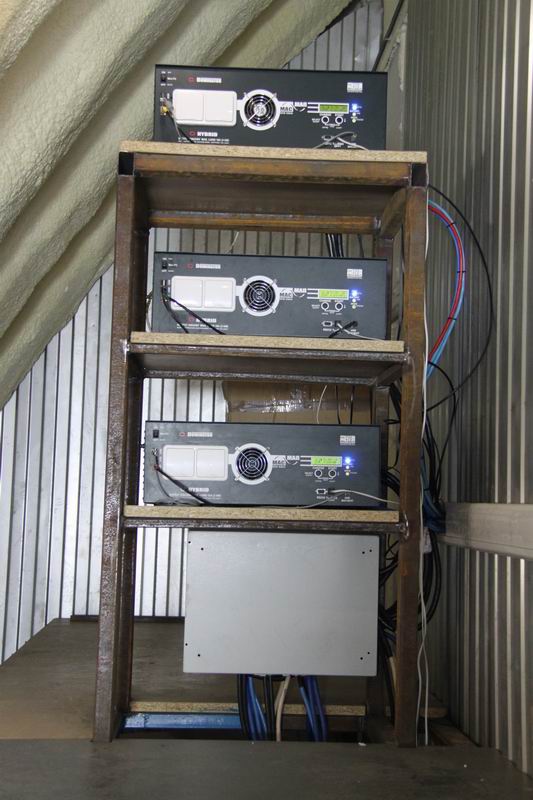
But this system is assembled with this feature in mind and is a hybrid network. In order for the external power network to disappear, the solar power station continues to work, there is a hybrid inverter MicroART MAP Dominator in a three-phase version. 3 blocks of 20 kW each can operate autonomously using the energy stored in batteries. I'll return to them a little later, and now I will tell about these inverters. It is these inverters that create the reference network when external power is lost. They give out a pure sine wave, pump from batteries up to 20 kW per each phase, but only if there is not enough solar energy. The network controller relies on this network and boosts the maximum required power from the sun. But if there is no sun, then the inverters operate autonomously. When the batteries approach the discharge, the system itself starts the diesel generator,
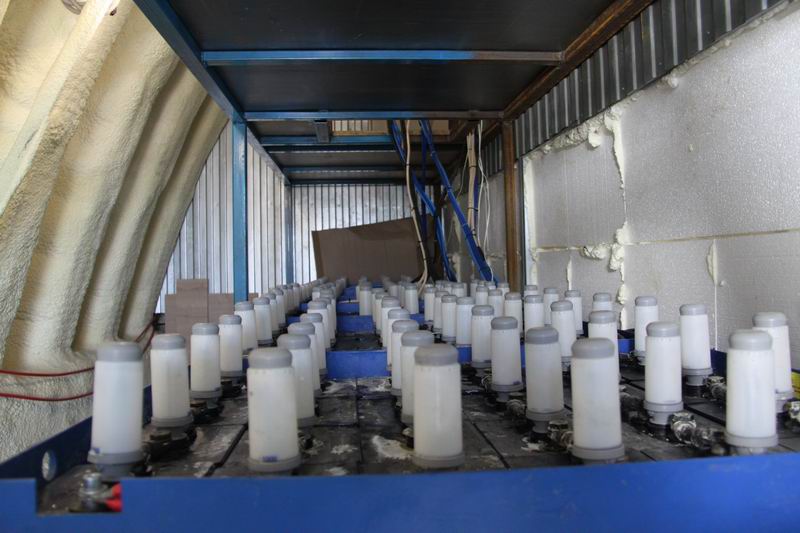
Now go to the batteries. Used armored traction lead-acid batteries produced in Tyumen. Each bank has a capacity of 960A * h and a voltage of 2V. They are assembled in blocks of 48V, and the total capacity is 5760 Ah. With a maximum inverter power of 60 kW and the absence of the sun, these batteries can provide energy for more than 4 hours of battery life. Those who are faced with lead-acid batteries (almost everyone under the hood has one or even two cars) know that the electrolyte evaporates in them over time and needs to be replenished. To avoid this process in such volumes, and these are 156 cans, hydrogen recovery plugs are installed. They are visible on the photo in the form of white cylinders.
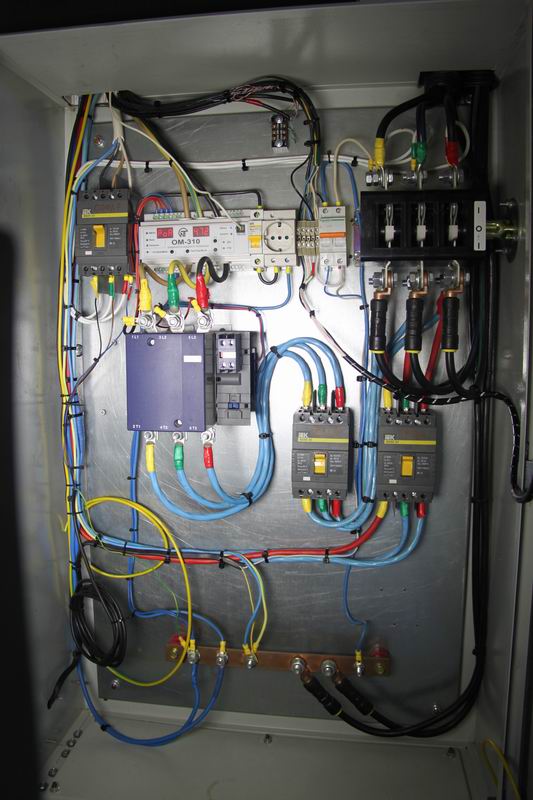
External network and autonomous system is switched in a separate box. The three-phase network arrives at the MSB and from there enters the internal network of the enterprise, from where it passes through the MAP Dominator and then goes to consumers.

In order to monitor the current state of the power system, the Raspberry system was used - this is a software and hardware complex of Russian MAP inverters. It allows not only to monitor everything that happens with the inverter in real time, but also to send alerts via e-mail or SMS. That is, the external network has disconnected - a message has arrived. Batteries are hooked to a certain level - another message has come. Batteries ran out and the diesel generator automatically started - a message arrived. For example, I find out while sitting at work that electricity was lost in my house and I immediately call the power engineers. And, often, I find out about this before them.
This system has one feature. Usually a solar power station is built as follows: solar panels -> solar controller -> battery -> inverter. This is the autonomous system. In this case, the batteries do not have direct contact with the solar controller. Therefore, the autonomous mode is implemented as follows: the solar energy collected by solar panels falls on the MPPT network inverter controller. The network inverter Sofar pumps energy into the network. Inverters MAP Dominator broadcast a mains voltage of 380 V through themselves, and if 380 V disappears in the network, they create a reference network of 380 V and if it happens that the batteries are discharged, they begin to charge the batteries and still create the reference network. Explaining is more difficult than it actually works.
Economy

After the installation of the solar power station, the operating time of the diesel generator was reduced by 4 times. After connecting the external network, the generator starts up for a check once a month and does not work for power production at all. In April, the output of the solar power plant was 3.5 MW * h, in May the consumption was 2 MW * h, but only because the electric boiler was disconnected, that is, there was no place to spend energy. The maximum output per month should be 5 MW * h, but for now the production is growing and all the available amount of solar energy is simply not consumed.
Since electricity is more expensive for legal entities than for individuals, the payback period of this power plant was calculated. For this object it was 4 years, which is not so much for the activity of the enterprise.
In addition, a simple enterprise or machine failure due to a sudden disconnection of the external power grid is significantly more expensive than the installed solar power station.
Conclusion
The hybrid grid power plant, assembled from foreign and Russian components, has already begun to justify its cost. 4 years after installation, the owner will pay for it in full. And if they adopt a law on the possibility of selling the generated energy from small solar power plants to the grid (to individuals or legal entities), the owner will simply begin to give up excess energy and make money on it. Monitoring with the help of PAK Malina allows you to remotely monitor everything that happens and be aware of the situation with the power system of production. Well, the reliability of solar power plants and minimal maintenance make ownership of such a system extremely easy.
Next time I will talk about a 120 kW solar power station !
Those who are too lazy to read, can watch the video, and those who like letters and pictures - under the cat
To begin with, the production is engaged in sawing and chromium laminating. Construction of hangars began in the open field and at first there was no power at all. Therefore, a 30 kW diesel generator was installed. They warmed themselves with a solid fuel stove, and the generator provided the power supply for the vehicles.

Pretty soon, the owner of the production thought about the cost of electricity received from the generator and came to the conclusion that it is foolish not to use the free energy of the sun, since all the production is in the Krasnodar region, where the sun is more than enough! Therefore, the task was to make the main source of energy a solar power station, and a backup diesel generator.
The first step was the miscalculation and presentation of several projects, of which one was chosen. After that, the equipment was mounted and running. Installation was carried out directly on the hangar itself. Since it is a semicircle, it turned out to be very easy to choose the optimal angle of the panels. Here and the sun is enough and the snow will not linger. In addition, the length of the hangar will increase the number of solar panels, if you need more energy.

Currently installed 100 panels with a capacity of 270 watts each. Polycrystalline panels were chosen, since they have a slightly lower cost, which made it possible to reduce the price of the system. Still, commercial exploitation implies a balance of price-quality. Since 27 kW is a serious power, especially since the panels produce direct current, the decision was made to use a mains inverter that supports the input voltage from the panels up to 1000 Volts. It turned out 4 blocks of solar batteries connected in series of 25 pieces. Operating voltage rose to 930 V.

To transfer the voltage from the battery to the solar controller, a standard wire with a cross section of 6 sq. Mm was used, the coating of which is not afraid of ultraviolet radiation and various weather conditions. Despite the fact that each block of solar panels gives almost 7 kW, the current is 7-8 Amps, that is, for a given cross section, the current flow and losses are minimal.

All energy from solar panels is collected by the Sofar 30000TL device. This is a three-phase mains inverter that is equipped with two MPPT controllers at once and can process up to 33 kW of solar energy. The advantage is that it works without batteries, and the minus results from the advantages - it can only work with a three-phase 380 V back-up network. That is, if the external network turns off, it will turn into a pumpkin and the solar panels will become a decoration.

But this system is assembled with this feature in mind and is a hybrid network. In order for the external power network to disappear, the solar power station continues to work, there is a hybrid inverter MicroART MAP Dominator in a three-phase version. 3 blocks of 20 kW each can operate autonomously using the energy stored in batteries. I'll return to them a little later, and now I will tell about these inverters. It is these inverters that create the reference network when external power is lost. They give out a pure sine wave, pump from batteries up to 20 kW per each phase, but only if there is not enough solar energy. The network controller relies on this network and boosts the maximum required power from the sun. But if there is no sun, then the inverters operate autonomously. When the batteries approach the discharge, the system itself starts the diesel generator,

Now go to the batteries. Used armored traction lead-acid batteries produced in Tyumen. Each bank has a capacity of 960A * h and a voltage of 2V. They are assembled in blocks of 48V, and the total capacity is 5760 Ah. With a maximum inverter power of 60 kW and the absence of the sun, these batteries can provide energy for more than 4 hours of battery life. Those who are faced with lead-acid batteries (almost everyone under the hood has one or even two cars) know that the electrolyte evaporates in them over time and needs to be replenished. To avoid this process in such volumes, and these are 156 cans, hydrogen recovery plugs are installed. They are visible on the photo in the form of white cylinders.

External network and autonomous system is switched in a separate box. The three-phase network arrives at the MSB and from there enters the internal network of the enterprise, from where it passes through the MAP Dominator and then goes to consumers.

In order to monitor the current state of the power system, the Raspberry system was used - this is a software and hardware complex of Russian MAP inverters. It allows not only to monitor everything that happens with the inverter in real time, but also to send alerts via e-mail or SMS. That is, the external network has disconnected - a message has arrived. Batteries are hooked to a certain level - another message has come. Batteries ran out and the diesel generator automatically started - a message arrived. For example, I find out while sitting at work that electricity was lost in my house and I immediately call the power engineers. And, often, I find out about this before them.
This system has one feature. Usually a solar power station is built as follows: solar panels -> solar controller -> battery -> inverter. This is the autonomous system. In this case, the batteries do not have direct contact with the solar controller. Therefore, the autonomous mode is implemented as follows: the solar energy collected by solar panels falls on the MPPT network inverter controller. The network inverter Sofar pumps energy into the network. Inverters MAP Dominator broadcast a mains voltage of 380 V through themselves, and if 380 V disappears in the network, they create a reference network of 380 V and if it happens that the batteries are discharged, they begin to charge the batteries and still create the reference network. Explaining is more difficult than it actually works.
Economy

After the installation of the solar power station, the operating time of the diesel generator was reduced by 4 times. After connecting the external network, the generator starts up for a check once a month and does not work for power production at all. In April, the output of the solar power plant was 3.5 MW * h, in May the consumption was 2 MW * h, but only because the electric boiler was disconnected, that is, there was no place to spend energy. The maximum output per month should be 5 MW * h, but for now the production is growing and all the available amount of solar energy is simply not consumed.
Since electricity is more expensive for legal entities than for individuals, the payback period of this power plant was calculated. For this object it was 4 years, which is not so much for the activity of the enterprise.
In addition, a simple enterprise or machine failure due to a sudden disconnection of the external power grid is significantly more expensive than the installed solar power station.
Conclusion
The hybrid grid power plant, assembled from foreign and Russian components, has already begun to justify its cost. 4 years after installation, the owner will pay for it in full. And if they adopt a law on the possibility of selling the generated energy from small solar power plants to the grid (to individuals or legal entities), the owner will simply begin to give up excess energy and make money on it. Monitoring with the help of PAK Malina allows you to remotely monitor everything that happens and be aware of the situation with the power system of production. Well, the reliability of solar power plants and minimal maintenance make ownership of such a system extremely easy.
Next time I will talk about a 120 kW solar power station !
